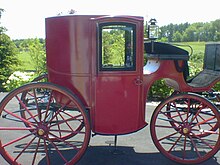
A coupe or coupé is a passenger car with a sloping or truncated rear roofline and typically with two doors.

A carriage is a two- or four-wheeled horse-drawn vehicle for passengers. Second-hand private carriages were common public transport, the equivalent of modern cars used as taxis. Carriage suspensions are by leather strapping or, on those made in recent centuries, steel springs. Two-wheeled carriages are usually owner-driven.

A wagon or waggon is a heavy four-wheeled vehicle pulled by draught animals or on occasion by humans, used for transporting goods, commodities, agricultural materials, supplies and sometimes people.

The hansom cab is a kind of horse-drawn carriage designed and patented in 1834 by Joseph Hansom, an architect from York. The vehicle was developed and tested by Hansom in Hinckley, Leicestershire, England. Originally called the Hansom safety cab, it was designed to combine speed with safety, with a low centre of gravity for safe cornering. Hansom's original design was modified by John Chapman and several others to improve its practicability, but retained Hansom's name.

A buggy refers to a lightweight four-wheeled carriage drawn by a single horse, though occasionally by two. Amish buggies are still regularly in use on the roadways of America. The word "buggy" has become a generic term for "carriage" in America.

Coupé de ville is a car body style produced from 1908 to 1939. It has an external or open-topped driver's position, as well as an enclosed compartment for passengers. Although the different terms may have once had specific meanings for certain car manufacturers or countries, the terms are often used interchangeably.

A phaeton was a form of sporty open carriage popular in the late eighteenth and early nineteenth century. Drawn by one or two horses, a phaeton typically featured a minimal very lightly sprung body atop four extravagantly large wheels. With open seating, it was both fast and dangerous, giving rise to its name, drawn from the mythical Phaëthon, son of Helios, who nearly set the Earth on fire while attempting to drive the chariot of the Sun.
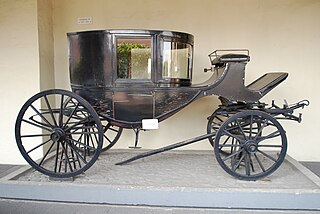
A clarence is a type of carriage that was popular in the early 19th century. It is a closed, four-wheeled horse-drawn vehicle with a projecting glass front and seats for four passengers inside. The driver sat at the front, outside the carriage. The clarence was named after Prince William, Duke of Clarence and St Andrews, later King William IV of the United Kingdom, who died in 1837. It was introduced in 1840 in London. The Brougham was a lighter, two-passenger version originally commissioned by Lord Brougham.
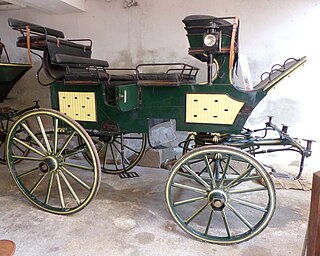
A break or brake is an open horse-drawn carriage commonly used in the 19th and early 20th centuries. It is a heavy four-wheeled vehicle with a high seat for the driver, pulled by two or four horses. Originally, it was used to break young horses to drive or for exercise, so it didn't have much body and was less finished than a formal carriage. Starting in the mid-1800s, the break became popular as a gentleman-driven carriage and many variations appeared. Originally spelled break in England, the spelling brake became common in the latter part of the 1800s and both spellings are used interchangeably.
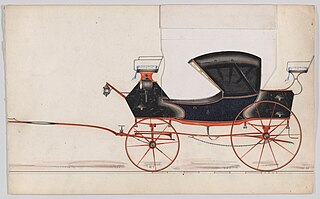
A britzka or britschka is a type of horse-drawn carriage. What was originally an open wagon in Poland and Eastern Europe, became a passenger vehicle in Austria and was exported to Western Europe where it became popular as a travelling carriage. The carriage had four wheels, a long body with two seats, and a folding hood over the rear seat. The body could be converted to sleep two people full length. There was an elevated seat for the driver in front and a rear platform with a rumble seat for servants

A Berlin or Berline carriage is a type of enclosed four-wheeled carriage with two interior bench seats facing one-another. Initially noted for using two perch rails and having the body suspended by leather straps called braces, the term continued in use for many carriages even after the suspension system changed to steel springs.

A horse-drawn vehicle is a piece of equipment pulled by one or more horses. These vehicles typically have two or four wheels and were used to carry passengers or a load. They were once common worldwide, but they have mostly been replaced by automobiles and other forms of self-propelled transport but are still in use today.
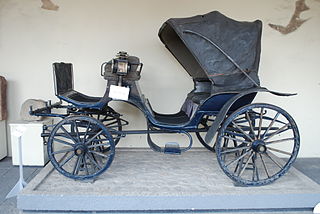
The victoria is an elegant style of doorless four-wheeled open carriage, drawn by one or two horses, based on the phaeton with the addition of a coachman's seat at the front, and with a retractable roof over the passenger bench.

A tonga or tanga is a two-wheeled cart drawn by a single horse. It is used for transportation in the Indian subcontinent. There is a canopy over the body, one seat faces forward for the driver and one passenger, and one seat faces the rear for a second passenger. Some space is available for baggage below the carriage, between the wheels. This space is often used to carry hay for the horses.
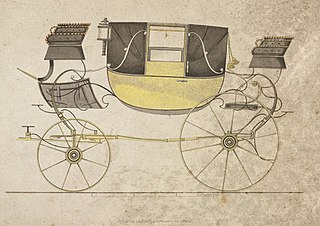
In coachbuilding, a landau is a four-wheeled carriage with a roof that can be let down. It was a luxury carriage. The low shell of the landau provides maximal visibility of the occupants and their clothing, a feature that makes a landau still a popular choice for Lord Mayors in the United Kingdom on ceremonial occasions.

A coach is a large, closed, four-wheeled, passenger-carrying vehicle or carriage usually drawn by two or more horses controlled by a coachman, a postilion, or both. A coach has doors in its sides and a front and a back seat inside. The driver has a raised seat in front of the carriage to allow better vision. It is often called a box, box seat, or coach box. There are many types of coaches depending on the vehicle's purpose.

A cabriolet is a light horse-drawn vehicle, with two wheels and a single horse. The carriage has a folding hood that can cover its two occupants, one of whom is the driver. It has a large rigid apron, upward-curving shafts, and usually a rear platform between the C springs for a groom. The design was developed in France in the eighteenth century and quickly replaced the heavier hackney carriage as the vehicle for hire of choice in Paris and London.

A brougham was originally a car body style where the driver sat outside and passengers seated within an enclosed cabin, — deriving the configuration from the earlier brougham horse-drawn carriage. Similar in style to the later town car, the brougham style was used on chauffeur-driven petrol and electric cars.

A wagonette or waggonette, meaning little wagon, is a four-wheeled open carriage drawn by one or two horses. It has a front seat for the driver, and passengers enter from the rear and sit face to face on longitudinal bench seats. Originating around the 1840s, the body is mounted on four sets of springs.

A coupé was a four-wheeled carriage with outside front seat for the driver and enclosed passenger seats for two persons. The name coupé comes from the French past participle of couper, "cut".

